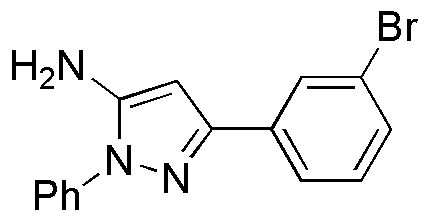5-(3-Bromophenyl)-2-phenyl-2H-pyrazol-3-ylamine is widely utilized in research focused on:
- Pharmaceutical Development: This compound serves as a key intermediate in the synthesis of novel pharmaceuticals, particularly in the development of anti-cancer agents due to its ability to inhibit specific enzymes involved in tumor growth.
- Agricultural Chemistry: It is applied in the formulation of agrochemicals, enhancing crop protection products by acting as a potent fungicide, which helps in managing plant diseases effectively.
- Material Science: The compound is used in the development of advanced materials, including polymers and coatings, which exhibit improved thermal stability and mechanical properties, making them suitable for high-performance applications.
- Biochemical Research: It plays a role in studying biochemical pathways, particularly in understanding the mechanisms of action of various biological processes, which is crucial for drug discovery and development.
- Diagnostic Applications: This chemical is explored in the creation of diagnostic tools, particularly in assays that detect specific biomolecules, thereby aiding in early disease diagnosis and monitoring.
General Information
Properties
Safety and Regulations
Applications
5-(3-Bromophenyl)-2-phenyl-2H-pyrazol-3-ylamine is widely utilized in research focused on:
- Pharmaceutical Development: This compound serves as a key intermediate in the synthesis of novel pharmaceuticals, particularly in the development of anti-cancer agents due to its ability to inhibit specific enzymes involved in tumor growth.
- Agricultural Chemistry: It is applied in the formulation of agrochemicals, enhancing crop protection products by acting as a potent fungicide, which helps in managing plant diseases effectively.
- Material Science: The compound is used in the development of advanced materials, including polymers and coatings, which exhibit improved thermal stability and mechanical properties, making them suitable for high-performance applications.
- Biochemical Research: It plays a role in studying biochemical pathways, particularly in understanding the mechanisms of action of various biological processes, which is crucial for drug discovery and development.
- Diagnostic Applications: This chemical is explored in the creation of diagnostic tools, particularly in assays that detect specific biomolecules, thereby aiding in early disease diagnosis and monitoring.
Documents
Safety Data Sheets (SDS)
The SDS provides comprehensive safety information on handling, storage, and disposal of the product.
Product Specification (PS)
The PS provides a comprehensive breakdown of the product’s properties, including chemical composition, physical state, purity, and storage requirements. It also details acceptable quality ranges and the product's intended applications.
Certificates of Analysis (COA)
Search for Certificates of Analysis (COA) by entering the products Lot Number. Lot and Batch Numbers can be found on a product’s label following the words ‘Lot’ or ‘Batch’.
*Catalog Number
*Lot Number
Certificates Of Origin (COO)
This COO confirms the country where the product was manufactured, and also details the materials and components used in it and whether it is derived from natural, synthetic, or other specific sources. This certificate may be required for customs, trade, and regulatory compliance.
*Catalog Number
*Lot Number
Safety Data Sheets (SDS)
The SDS provides comprehensive safety information on handling, storage, and disposal of the product.
DownloadProduct Specification (PS)
The PS provides a comprehensive breakdown of the product’s properties, including chemical composition, physical state, purity, and storage requirements. It also details acceptable quality ranges and the product's intended applications.
DownloadCertificates of Analysis (COA)
Search for Certificates of Analysis (COA) by entering the products Lot Number. Lot and Batch Numbers can be found on a product’s label following the words ‘Lot’ or ‘Batch’.
*Catalog Number
*Lot Number
Certificates Of Origin (COO)
This COO confirms the country where the product was manufactured, and also details the materials and components used in it and whether it is derived from natural, synthetic, or other specific sources. This certificate may be required for customs, trade, and regulatory compliance.


